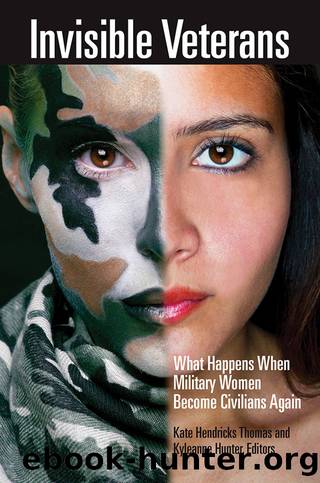Invisible Veterans by Kate Hendricks Thomas & Kyleanne Hunter

Author:Kate Hendricks Thomas & Kyleanne Hunter
Language: eng
Format: epub
Publisher: ABC-CLIO
Stories of LGBTQ Women Warriors
Deborah Samson was born in 1760 in Plympton, Massachusetts. As an indentured servant to a family with 10 sons, Samson worked on a farm and learned to read and write, eventually becoming a school teacher and waitress. At the age of 22, Samson enlisted in the Revolutionary Army using the name Robert Shurtlieff. This was the second time Samson had attempted to join the Revolutionary Army. The first time she was discovered as a woman and could not serve her term. As Robert Shurtlieff, Samson would serve for over one year and was wounded twice in combat (Kravitz, 1999; Zagarri, 2005). We cannot use present-day constructs of transgender identity to discuss Samsonâs life. For one, the concept of being transgender did not exist in 1827. It is also unclear if Samson donned menâs attire for the sole purpose of joining the military or because of an internal sense of being a man. That said, we can note that gender fluidity has been a part of the U.S. military since its inception. Interestingly, the military is one of Americaâs institutions that requires the most heavily regimented gender performance (Belkin, 2012).
Considering the documented history of Samson in 1827, lesbian and bisexual womenâs stories of military service do not appear until much later in history including during the Civil War and World War I (Shilts, 1994). The silence of these narratives is consistent with historical precedent, where the stories of lesbian women, particularly lesbians of color, are lost or suppressed (Berube, 2001; Walter, 2010). This is especially troubling when considering the fact that the Donât Ask, Donât Tell (DADT) policy, which excluded lesbian, gay, and bisexual people from serving in the U.S. military, disproportionately impacted lesbian women and especially lesbians of color (Gates, 2010).
Lesbian, bisexual, and transgender womenâs experience of military service and the policies governing their service have been inextricably linked to trauma. Anti-LGBT military policies like DADT silenced many survivors of military sexual trauma (MST) who were told they would be accused of being LGBT if they reported the MST by their assailants (Booth, Mengeling, Torner, & Sadler, 2011; Burks, 2011; Hunter, 2007; Shilts, 1994). When compared to heterosexual service members, LGBT service members experienced higher rates of sexual assault, sexual harassment, and gender discrimination during their military service (Department of Defense, 2017). One study found prevalence rates of MST as high as 20 percent among transgender men and 14 percent among transgender women veterans (Lindsay et al., 2016). Among lesbian and bisexual women who served in Afghanistan and Iraq, 31 percent reported MST compared to 13 percent of heterosexual women (Mattocks et al., 2013). Another study found that LGB service members are twice as likely to experience sexual assault during their service as compared to heterosexual service members and that these assaults are significantly associated with post-traumatic stress disorder (PTSD) and depression (Lucas, Goldbach, Mamey, Kintzle, & Castro, 2018).
Unfortunately, the narrative of women in the U.S. military is often one of victimhood (Howard & Prividera, 2008).
Download
This site does not store any files on its server. We only index and link to content provided by other sites. Please contact the content providers to delete copyright contents if any and email us, we'll remove relevant links or contents immediately.
Should I Stay or Should I Go? by Ramani Durvasula(7571)
The Lost Art of Listening by Michael P. Nichols(7412)
The Rosie Project by Graeme Simsion(6202)
Beartown by Fredrik Backman(5609)
We Need to Talk by Celeste Headlee(5547)
Ego Is the Enemy by Ryan Holiday(5297)
Hunger by Roxane Gay(4869)
Suicide Notes by Michael Thomas Ford(4765)
I Love You But I Don't Trust You by Mira Kirshenbaum(3810)
Mummy Knew by Lisa James(3637)
Not a Diet Book by James Smith(3342)
Crazy Is My Superpower by A.J. Mendez Brooks(3334)
Toxic Parents by Susan Forward(3231)
Girl, Wash Your Face by Rachel Hollis(3210)
The Complete Idiot's Guide to Coping With Difficult People by Arlene Uhl(3118)
Name Book, The: Over 10,000 Names--Their Meanings, Origins, and Spiritual Significance by Astoria Dorothy(2942)
The Social Psychology of Inequality by Unknown(2941)
The Hard Questions by Susan Piver(2928)
The Gaslight Effect by Dr. Robin Stern(2740)
